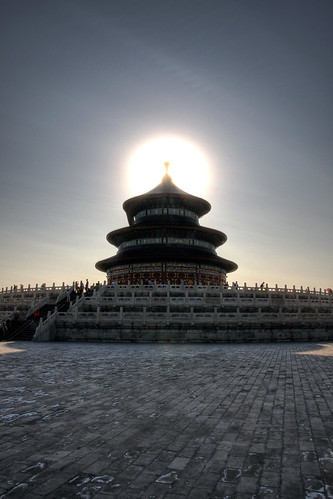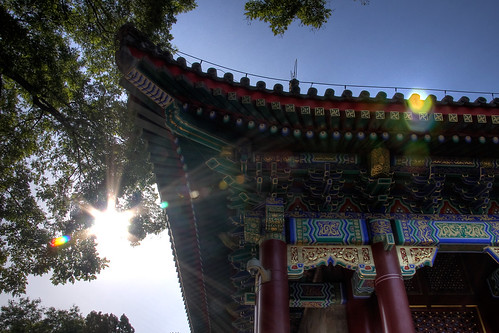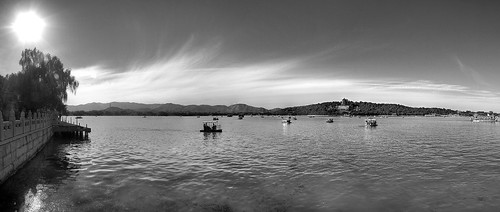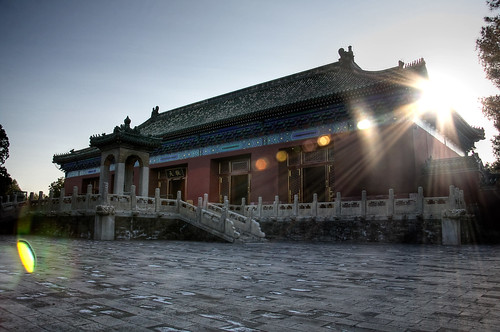Only 20 years ago Beijing was mocked being the largest village in the world. After a rapid restructuring of the city and finally due to the 2008 Summer Olympic Games, Beijing quickly evolved to a modern cosmopolitan city. Fortunately, the city managed to keep its charm.
I had the opportunity to travel to Beijing thanks to a publication I submitted and had accepted at one of the largest computer science conferences in the world. I’ve never been outside Europe, so I was especially excited. Because Beijing lies almost exactly at the opposite side of the Earth, it was also the first time in my life to take a flight lasting over 9 hours. Some of my colleagues warned me about the jetlag – which I never experienced before, and I have to admit, I still don’t really know how it feels like. (A 2 day bus trip across Europe is much worse.) A friend of mine joined me for the conference, we wrote the publication together. We took off at Saturday evening from Germany and landed on Sunday at noon in Beijing, so if you managed to get some sleep on the plane, it felt just like a day when you got out a little late from bed. Several friends and also people we met on the plane advised to first take a taxi to the hotel and not to try the subway. Later on we learned that the subway is absolutely no problem for anyone who speaks English. But att the capital airport of Beijing we first went to the taxi stand. On the way several people asked us whether we needed a taxi. You shouldn’t go with them, because they’ll charge you a lot more money than a registered cab driver. Despite the unbelievable heavy traffic, we managed to get from the airport to our hotel (about 32kms across Beijing) in only 45 minutes. We booked a room in the same hotel where the conference was held too. The Beijing Friendship Hotel is one of the oldest hotels in Beijing and it is famous for its traditional Chinese architecture. Also its location was perfect: the next subway station is directly in front of the hotel.
After checking in to the hotel and having a quick refreshment we had a free afternoon. We picked the closest place of interest, the Summer Palace. On the map it appeared really close, but in Beijing the distances are huge. We took the subway and we still needed about 25 minutes to get to China’s biggest and best preserved garden. More than 100 years ago this was Empress Dowager Cixi’s most favorite residency to spend the summer, which can be explained by the good berth of the garden and also the chilling effect of the central Kunming Lake. We immediately noticed how it feels to be in the capital of a country with more than 1.3 billion people. An unbelievable amount of people tried to get along the quite narrow pathways. Despite the masses, the garden was very enchanting due to its beautiful view at the surrounding mountains. This was the only place in Beijing where the panorama was not disturbed by some recently erected high-rises. Probably the most wonderful view is from the central small island, which you can enter through a more than 100m long bridge with 17 arches. The lake was full with dozens of pedal boats, in between two ferries were trying to get from one port to the next. You can also walk around the whole lake, and with some luck you might even discover some silent spots. I would advise to plan at least a half day for the Summer Palace, or even a whole day if you plan to visit the Wanliu and Haidian Parks or the Old Summer Palace (Yuanming Yuan).
On Sunday evening we were invited to the first official part of the conference: the opening welcome reception. Hungarians tend to find each other pretty easily – I managed to get in contact with all Hungarian participants already during this first evening. This was also very practical, because in the following days we regularly exchanged information about where to go, what to see, when and most importantly: how to get there best. The next 4 days went along with a very well organized conference with many interesting presentations. Despite the wonderful sunny weather, we managed to get out to the city only during the evening. Fortunately, the beautiful weather lasted some more days, so in our two added days after the conference we still had wonderful sunshine for visiting all the sights in Beijing. September/October and April/May are the best month to visit Beijing. The temperature is around 23-28°C and there’s almost no rain (the rainy season is actually during July and August).
Looking at the map of Beijing, many sights seem quite close, but this appearance is deceptive. Many sights are huge on their own, e.g. the Tian’anmen Square alone is 880m long! So at the sights alone you’ll be walking around a lot. In most cases you have to take a public transport. Which are pretty good in Beijing by the way. The most simple one is the subway, which was heavily modernized and extended for the 2008 Summer Olympic Games. All stations tell you both in Chinese and English where to go and what to do, and on the subway itself there’s an English voice too telling you what the next station will be. You can also track the current position of the subway on its route, so the subway system is very simple and convenient. And cheap! A ticket costs you only 2 Yuan (30 cents) and is valid for the whole subway system. Only the train ticket to the airport costs you 25 Yuan (4 dollars) separately. Tickets should always be bought right at the station, because they are valid only for the current station and day. So pre-buying a return ticket is useless. Another public transport is the bus system of Beijing. The buses looked modern but we never tried them, because the bus network was even more huge and the subway took us to all places we needed.
On a free afternoon we visited the Temple of Heaven at the Tiantan Park, which is China’s largest temple complex. The entrance ticket already contains admission to all main sights along the principal north-south axis, so no time has to be wasted at separate ticket desks. One of the most famous buildings of Beijing, the Hall of Prayer for Good Harvests (Qinian Dian) is located here too, which is something every tourist should see. Similarly to the Summer Palace, the main axis is extremely crowded, so unfortunately you cannot hear the sound effects at the famous Echo Wall as far as you’re not there early in the morning when the park opens its doors. Stepping away from the main north-south pathway, the park is almost empty and therefore gets much more enjoyable. You can walk around in the beautiful Rose Garden or at the Hall of Abstinence and visit the two pagodas in the northern part. Here you also might hear some Beijing citizens singing or clapping rhythmically in small groups. Between the precisely planted trees you might even spot some Chinese people exercising tai chi. For this park you should plan a half day too.
On Tuesday evening we were invited to the conference banquet where we enjoyed several short performances of Chinese specialties. Chinese are famous for their acrobatics, so we watched a girl balancing burning candles in pretty awkward positions. Afterwards we heard a short introduction to the Chinese opera, which is totally different to our western kind of opera. It includes much more acrobatics, color and noise. Finally, a girl balanced a huge 200kg heavy pot with her feet and at the end also a volunteer sat in the pot while being balanced. After the dinner and the program our host for the evening reminded us shortly that the next conference day would start at 9am. We didn’t really have time to analyze whether this reminder was a kind formulation of a throwing out, when suddenly all waiters and waitresses started a tsunami wave. In about 10 minutes they managed to clear the tables of all 300 guests and transformed the ballroom back into the conference venue. This exactness regarding closing times was very common in Beijing. Most ticket offices at sights close 30 or 60 minutes earlier as the sight itself. Some even close 10 or 15 minutes earlier as the officially scheduled time. In Beijing you should always be at your targeted destination on time and rather consider the opening times of the ticket desk – which might close already at 4pm in the afternoon.
While in Beijing, you should at least once take a trip by taxi. There is always a lot of traffic on the highways crossing and surrounding the city, so the journey might be long, but still its a unique experience. The driving style looks and feels pretty dangerous: the indicator light is hardly ever used by anyone, honking is almost constant (though in taxis the radio is usually extremely loud so you don’t hear anything from outside while sitting in a cab), 3-lanes often spontaneously become 4 if there’s some spare room and overtaking from the right using the parking lanes is common practice. Although for the latter action you have to be aware not to hit any grocery stands using those lanes. Sometimes you might even see (or sit in) a taxi suddenly stopping in the middle lane without any reason. Despite these driving habits, I have never witnessed a car accident during my stay. What was even more strange is the fact that none of the cars had any bumps or scratches at all. Taxis are in general very cheap in Beijing, e.g. our ride from the airport to our hotel cost us 88 Yuan (14 dollars). But still you should make sure to pick a licensed taxi driver and that the driver has activated the trip meter. Most drivers don’t speak any English at all, so it is advised to always keep at least the name of your hotel written in Chinese in your passport. If you might get lost in the city at least you’ll always find your way back home.
Not so long ago Beijing was famous for its many bicycles. With the modernization of the city, unfortunately, this picture changed rapidly too. There are still a lot of cyclists on the road, but no extreme masses. Many citizens doesn’t seem to like pedaling anymore, because electric motorcycles are very very popular. At least they are electric and so they don’t contribute to the city’s smog problem. At some points in the city you can also rent a bike, but I would rather not recommend it, because the traffic is quite dangerous. Anyway, the order for the right of way is based on the size of the vehicle, so first come the cars, then the motorbikes and bicycles and only at last the pedestrians. The current color of the traffic light is thereby completely irrelevant. Walking around as pedestrians I would advise to join locals, build spontaneous small groups and try to cross the street together.
After our first impressions of Beijing and some observations regarding the traffic and transport possibilities of the city, we tried to see as much as we could in our two free days. My next post will be about our city trip through Beijing.






That is so neat! My husband wants to go to China so badly – I think he’d love to read your post. 🙂
Thank you. Beijing felt very western / European, so to really get know China you’ll probably better off somewhere else than Beijing. Unfortunately, I didn’t have time to travel around in China to really see and feel the difference. Hopefully, next time.